Shrubs are great additions to any garden because they come in so many sizes, shapes, and varieties. One thing to think of when planting shrubs is using native varieties, which can help the landscape and pollinators. We included a few native plants on our list of the 10 best shrubs to plant in Ohio for your garden. Keep reading to learn about the many shrub species that do well in Ohio, from flowering to evergreen!
False Indigo
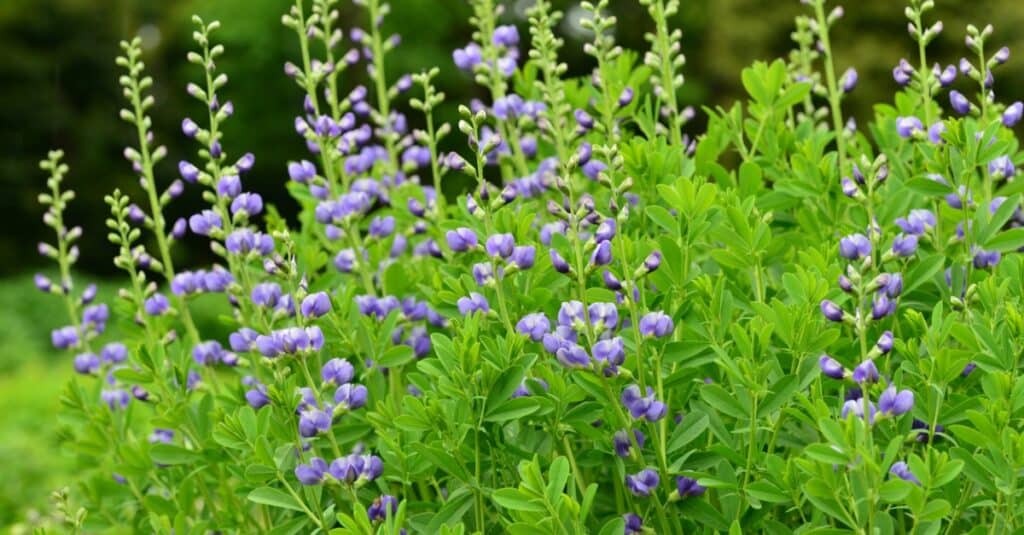
While false indigo takes a few years to start blooming, the flowers are well worth the wait.
©iStock.com/magicflute002
False indigo is the only violet-blue flowering plant that is native to Ohio. Since there aren’t many plants that have blue flowers, this one is a standout for gardens. The fact that it’s a native variety makes it even easier to make it our top choice! At this time, false indigo is considered endangered in Ohio, so planting native false indigo can help save an entire species.
False indigo is a perennial, so plant it once and you’ll get to enjoy the flowering shrub for years. The plant typically flowers from April through June and leaves black seed pods after the blooms fall. The plant reaches its full height of 4 to 5 feet about a year after it is planted and spreads to around 4 feet wide.
False indigo does best in moderately moist, well-draining soil and full to partial sun. You’ll want to plant it sometime between early spring and mid-summer. The plants take a while to establish but you’ll typically see blooms after the first or second year. False indigo is one of those plants that you’ll really have to baby at first, but once it’s established, there’s not much that will keep it from growing.
Crape Myrtle

Crape myrtles come in tons of colors including red, pink, orange, white, and purple!
©Satoshi Mizushima/Shutterstock.com
The first thing to note about crape myrtles is that they are heat-loving plants. They do best in Zones 7 to 9 as trees but can survive in colder places as shrubs. As the plant has grown in popularity, gardeners and arborists have created more cold-hardy varieties.
Something to keep in mind when growing crape myrtle in northern climates like Ohio is that it is more susceptible to mildew. You can potentially avoid this issue by planting the crape myrtle in full sun, but if that doesn’t work, there are a few other fixes. You can use fungicides or make your own from a mixture of baking soda and water.
Plant your crape myrtle in a spot that is blocked from the strongest winter winds and where the ground doesn’t usually stay frozen. The plant prefers full sun and rich, acidic soil. Help them through the winter by mulching around the base before the cold temperatures set in. Then, prune them in the spring to get the growth started again. Plant them in early spring after the last frost has occurred to give them time to establish before next winter.
Weigela

When it blooms, weigela is a show-out, covered with tons of gorgeous flowers.
©Orest Lyzhechka/iStock via Getty Images
Weigela is a top pick for almost any garden because it’s gorgeous, easy to grow, and extremely beneficial to pollinators. The plant is a favorite of butterflies and hummingbirds because of its tubular-shaped flowers. Weigela is a unique addition to the garden because some varieties have leaves that aren’t a typical green color. Some weigela have green leaves, others have variegated, creamy, or purple-green colored leaves, and some varieties are so dark that they appear almost black.
Weigela is native to Asia, but it was introduced to Europe in the 1800s and America shortly after. It did so well in the U.S. that growers began creating new cultivars, colors, and sizes.
Plant weigela in full sun for the best blooms and most colorful foliage. It grows best in well-draining, moist soil.
Rhododendron
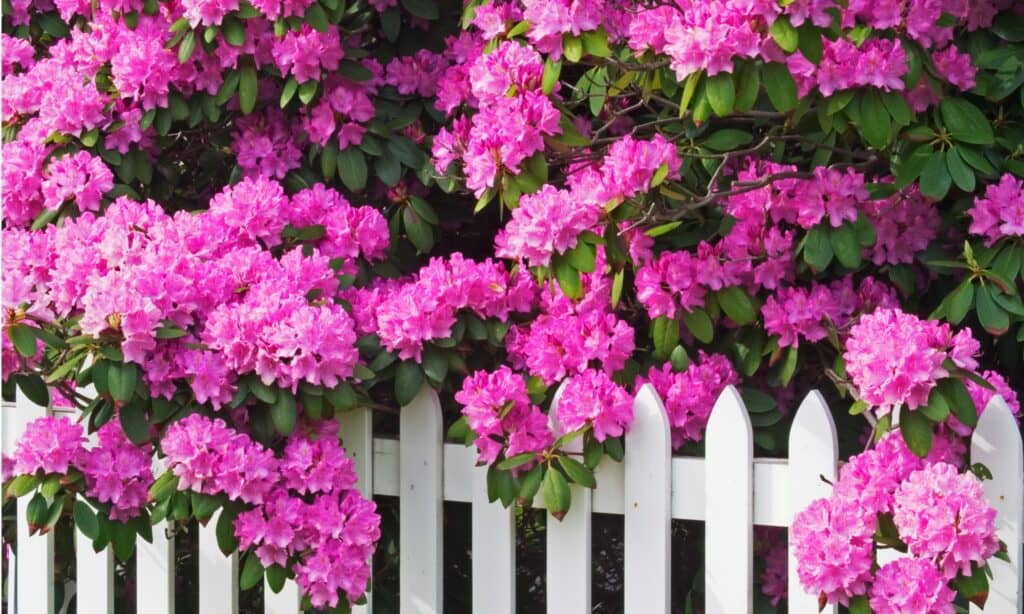
Rhododendrons can make for great privacy shrubs because of their dense foliage.
©iStock.com/dndavis
The most important thing to remember before planting rhododendrons is — peat! These plants do not survive well in alkaline soil, which makes up most of central and southern Ohio. You can add peat to the soil to increase the acidity.
Unlike their smaller relative, azaleas, rhododendrons can reach heights of 10 feet and widths of 20 feet. They do best in Zones 5 through 8, so Ohio is a great place to grow these picky plants.
By now, you’ve probably realized that rhododendrons have some preferences! The plant doesn’t like it to be too hot or too cold, it needs acidic, well-draining soil, and its sun preferences are just as exact. Rhododendrons prefer a spot with dappled shade — they don’t like full sun or full shade. You’ll want to plant this species in the late spring so it has time to establish before winter.
Hydrangeas
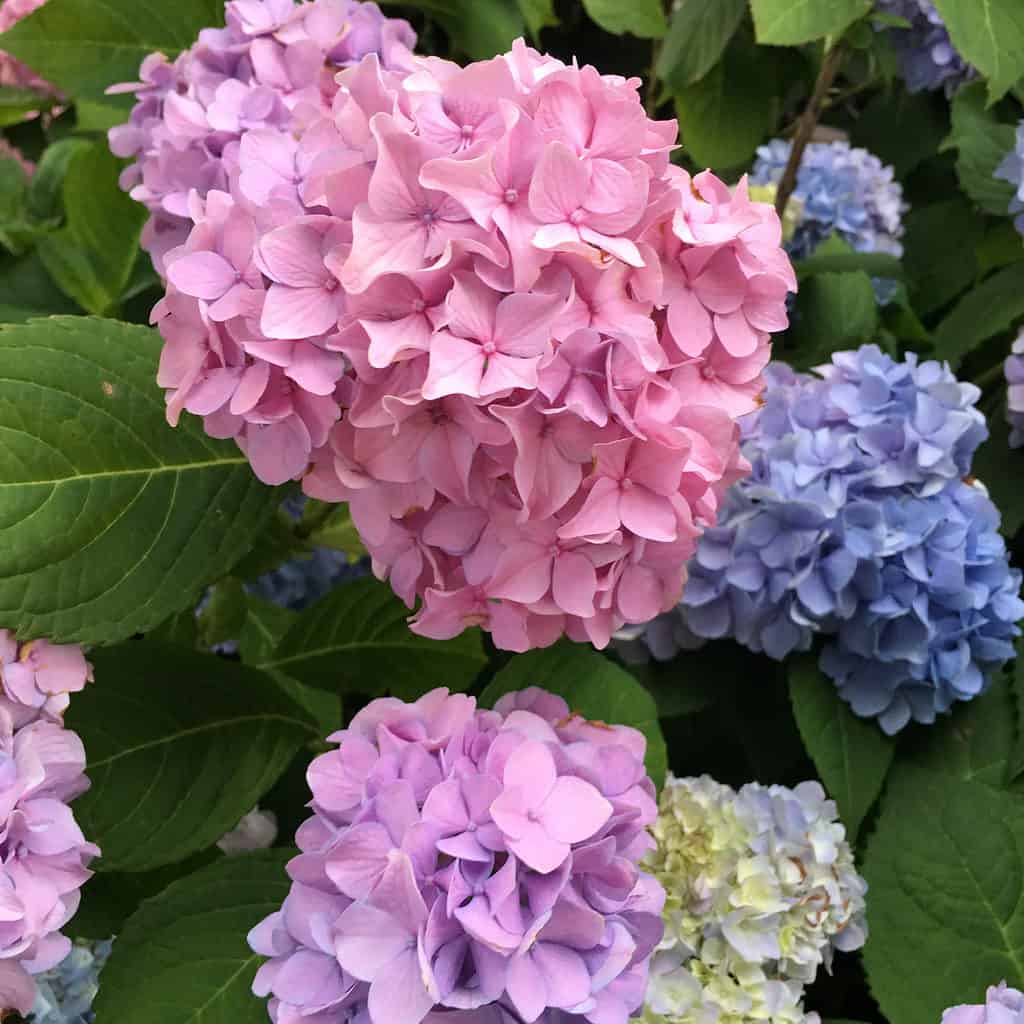
Some of the most ornamental flowers for vases come from hydrangeas.
©Kat_sy/Shutterstock.com
Hydrangeas are gorgeous flowering plants that come in tons of varieties. They boast large, beautiful blooms that make great centerpieces for tables and counters. If you’re interested in growing hydrangeas, the best time to plant them is during early spring or fall.
Hydrangeas can get pretty big, expanding up to 7 to 8 feet wide, so be careful where you plant them! They need plenty of room to thrive and reach their full blooming potential.
Plant your hydrangeas in rich, moist soil and partial sun. Ideally, they need a spot with morning sun and dappled afternoon sun or afternoon shade. Too much sun can cause their blooms and growth to be stunted.
Common Lilac
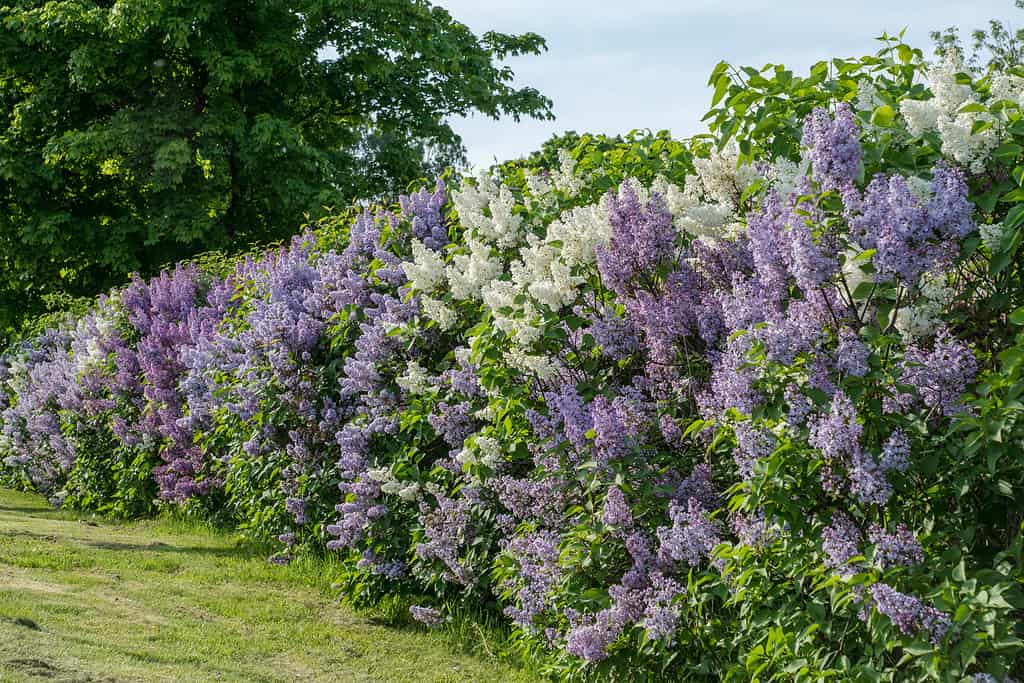
You can grow common lilac in rows as a hedge to enjoy the sweet flowery fragrances year after year.
©Binnerstam/iStock via Getty Images
Common lilac, or French lilac, is the most common of the lilac species, but there are plenty of varieties and colors if you want a different look. It’s easily recognizable by the small, clustered white, pink, and purple blooms. If the flowers don’t catch your eye, you surely can’t miss their lovely, sweet fragrance.
The only con to lilacs is that they are deciduous, so they will lose their leaves in the fall. If you want a plant that will stay green throughout winter, you’ll want to choose a different one on our list. Also, keep in mind that it’s best to plant lilacs in the late fall, so your first season won’t be the prettiest. But, if you’re willing to wait out the winter with your lilac, you’ll be met with new growth in spring and beautiful flowers by mid-summer.
Plant common lilac in a spot that gets full sun or you’ll miss out on lilac’s full blooming potential. The plants prefer moist, well-draining soil. Lilacs grow from anywhere between 5 and 15 feet, so plant them where they’ll have plenty of room to grow.
Japanese Quince
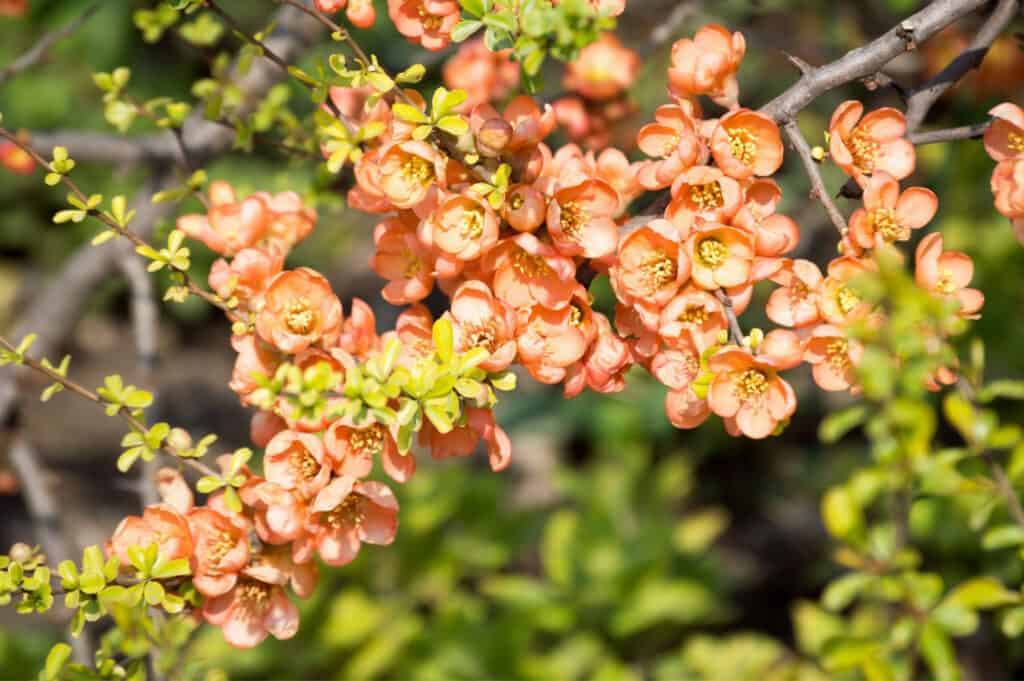
Flowering quince blossoms bloom directly on the branch, so avoid cutting back your shrub until after it flowers for the season.
©irisff/Shutterstock.com
Japanese quince, which is also called flowering quince, is the only shrub on our list that produces edible fruits (when cooked). Its flowers make Japanese quince a worthy addition to your yard, but its fruits are a bonus! You wouldn’t want to eat them raw, because they are astringent and extremely acidic, but you can use them in other ways. Their raw juices can be substituted for lemon juice. You can also cook the fruits into jams, jellies, and preserves.
Besides their unique, edible fruits, Japanese quince shrubs have plenty more to offer as well. They produce orange, pink, red, or white flowers each spring, with blooms lasting for 1 to 2 weeks before falling. These flowering shrubs may not have the longest blooming period, but when they bloom, they bloom in full with flowers covering every part of the plant!
Plant flowering quince in a spot with full sun and well-draining soil. It’s a pretty drought-tolerant plant after it’s established and it’s important not to overwater.
Pearlbush

It’s easy to see where this plant gets the name ‘pearlbush’ from.
©Dipakkumar Talati/iStock via Getty Images
Exochorda, or pearlbush, is a type of woodland shrub that is native to Asia. It’s very easy to grow and will reach heights (and widths) of 10-12 feet. Pearlbush shrubs get their name from the pattern in which their flowers grow — like a string of pearls. Each spring, around March, the green bush turns into a dazzling white display of blossoms. They keep their display for around 1 or 2 weeks before dropping the blooms.
During the rest of the year, pearlbush shrubs are fairly unnoticeable. But, that’s the kind of deal you get with a plant that literally thrives on neglect. Pearlbush shrubs are so easy to grow that you could nearly just throw them in the ground and forget about them!
If this shrub catches your eyes and heart, you’ll be happy to know that you can plant pearlbush almost any time of the year. But, like most plants, your best bet is during spring or fall, when the climate is temperate. Pearlbush thrives in full sun to partial shade in well-draining soil.
Winterberry Holly
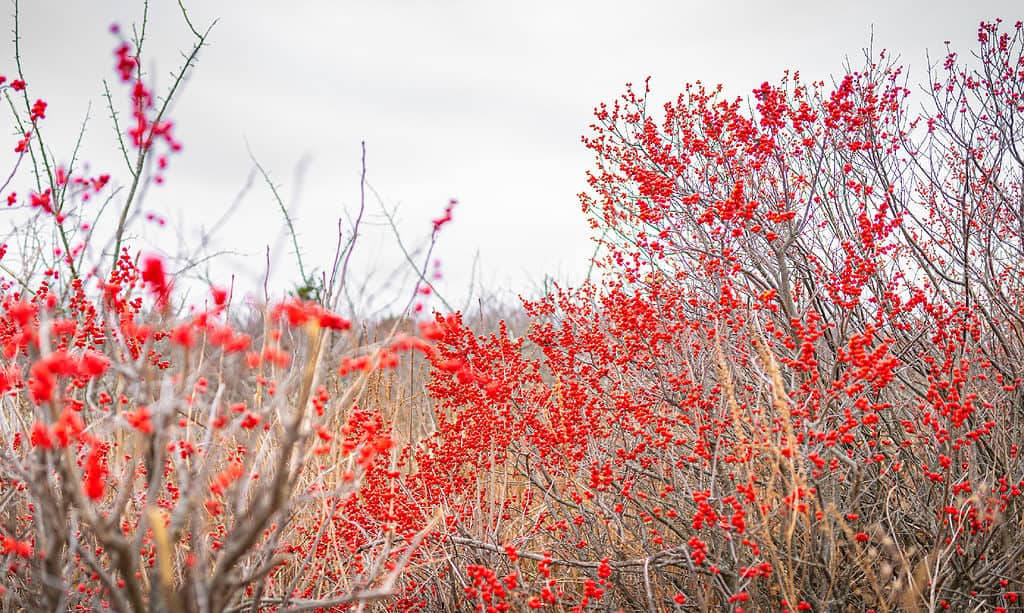
The winterberry is part of the Aquifoliaceae family and is essentially a holly shrub.
©iStock.com/Sanghwan Kim
Winterberry holly is another one of those ‘set it and forget it’ type plants. It’s super easy to grow and it’s native to Ohio, so there’s no reason not to include it in your garden! Unlike many of the other shrubs on our list, which are prized for their flowers, the star on these plants is their berries.
Winterberry is named for the bright red berries it produces during fall and early winter. Since it’s one of the only plants that adds color during the coldest time of the year, winterberry makes a great addition to your winter landscape. It’s important to note that winterberries are poisonous, so take caution if you have young children or pets.
Winterberry shrubs can only produce berries if they are pollinated, so you’ll need a male and female plant. Most nurseries will have them labeled for customers, but you can also tell by their blooms. Male shrubs have small flowers in clusters, and female shrubs have larger flowers that are more spread out.
The best time to plant winterberries is late summer to early fall, but spring planting is sometimes successful too. Plant them in a spot where they’ll have plenty of room to grow, in full sun, and moist, well-draining soil.
Juniper

Juniper comes in a few different varieties. Sky Rocket junipers are wider plants that grow in more of a pyramidal shape.
©iStock.com/beekeepx
Juniper is a gorgeous evergreen shrub that will look good year-round. It grows at a slow to medium speed but will reach heights of 30 feet and widths of 15 feet. It should look familiar — it’s the most common evergreen conifer in Ohio. Juniper grows as a tree or as a large shrub in a pyramid-like shape.
Juniper makes for a great windbreak, so plant it in any area where you need to block the wind. Make sure that there is plenty of space for the shrub to grow so that it’s not competing with other plants for water or nutrients.
Plant juniper during spring or early fall in full to partial sun. It’s not too picky but prefers moist, well-draining soil.
The Best Shrubs to Plant in Ohio
| # | Shrub | Best Spot |
|---|---|---|
| 1 | False Indigo | Moist, well-draining soil and full to partial sun |
| 2 | Crape Myrtle | Full sun and rich, acidic soil |
| 3 | Weigela | Moist, well-draining soil and full sun |
| 4 | Rhododendron | Acidic, well-draining soil and dappled shade |
| 5 | Hydrangea | Rich, moist soil and partial sun |
| 6 | Common Lilac | Full sun and moist, well-draining soil |
| 7 | Japanese Quince | Full sun and well-draining soil |
| 8 | Pearlbush | Full sun to partial shade and well-draining soil |
| 9 | Winterberry | Full sun and moist, well-draining soil |
| 10 | Juniper | Full to partial sun and moist, well-draining soil |
The photo featured at the top of this post is © Kabar/Shutterstock.com
Thank you for reading! Have some feedback for us? Contact the AZ Animals editorial team.







